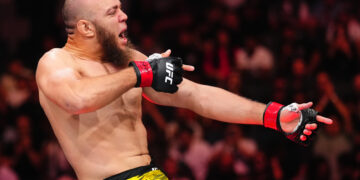
Brazilian Jiu-Jitsu is a martial art that thrives on the complex interplay between technique, leverage, and control. As practitioners dive deeper into the art, they encounter many unique positions and submissions, each offering unique possibilities. Among these techniques are the pinch headlock and shoulder crunch. These two techniques are effective tools used to control and sweep the opponent. This article breaks down the nuances of these techniques, offering insights for those seeking to understand their value.
What Is The Pinch Headlock?
The pinch headlock is a control position (usually done from the guard) that immobilizes an opponent’s head and neck. By using your arms and shoulders to pinch the opponent’s head and arm, you can effectively trap the opponent’s head, limiting their mobility and establishing the stage for various attacking opportunities.
The effectiveness of the pinch headlock lies in its ability to disrupt an opponent’s posture. In the sport of Brazilian Jiu-Jitsu, posture is the cornerstone of many attacks and defenses. By compromising an opponent’s posture, you can effectively neutralize their offense and, in turn, keep yourself safe. The pinch headlock achieves this by placing pressure on the neck and head, forcing the opponent to accept a compromised position. This then makes it easier for you to go on an offensive cycle.
What Is The Shoulder Crunch?
While the pinch headlock focuses on controlling the head, the shoulder crunch targets the opponent’s neck and shoulder. It’s done by trapping the opponent’s arm near the shoulder to apply pressure, creating a locking effect on the limb. You place your forearm across the opponent’s neck to push them upwards while keeping their arms tight. The shoulder crunch is not a brute force technique; it’s a move that requires precision, timing, and a solid understanding of human anatomy.
The great benefit of the shoulder crunch lies in its subtlety. Unlike some submissions that are pretty obvious in their application, the shoulder crunch can be applied stealthily, catching opponents off guard, especially when they are forced to post on the mat. When executed correctly, the shoulder crunch can lead to many high-percentage sweeps, submissions, and even back takes.
Using The Pinch Headlock And Shoulder Crunch
Note that the pinch headlock and shoulder crunch are not isolated techniques; they can and should be chained depending on the situation. Often, the pinch headlock serves as a precursor to the shoulder crunch. By first establishing control with the headlock, you can drag the opponent’s head and posture down. This makes it easy for you to either attack from the pinch headlock, a strong position in itself or move to the shoulder crunch.
This natural integration showcases the fluidity innate in Brazilian Jiu-Jitsu. Techniques flow into one another, creating chains of attacks that can overwhelm opponents. Mastering the transition from the pinch headlock to the shoulder crunch requires many hours of drilling and practice. Yes, it is easy to do the transition with an unresisting training partner, but doing this in live sparring is a different animal altogether. Grappling is a dance of pressure and movement; you should be able and ready to use the technique if the opportunity presents itself.
Techniques In Action
In this video, BJJ blackbelt Brian Glick shares his approach to the pinch headlock and shoulder crunch from the guard. As discussed above, the first step is to control the opponent’s posture by grabbing the head and forcing it down. From here, you can now move to the pinch headlock or shoulder crunch. There are many attacking options from these positions, but perhaps the most commonly used are variations of the hook sweep, moves you typically see in the butterfly guard.
This video is but a sample of the potential of these techniques. Gordon Ryan, the greatest No-Gi grappler on the planet, loves to use the pinch headlock and shoulder crunch. So much so that he was able to sweep the legendary Marcus “Buchecha” Almeida with a shoulder crunch sweep in the ADCC World Championships.
Mastering The Pinch Headlock And Shoulder Crunch
As with all techniques in Brazilian Jiu-Jitsu, mat time is the main ingredient to mastering techniques. We always advocate giving yourself several months of practice to become accustomed to a move you want to learn. This includes consistent study, troubleshooting, and testing in live rolling. Aside from these, here are several tips to help you on your journey to mastery.
- Focus On Technique, Not Strength: While it might be tempting to rely on brute strength, especially when applying the shoulder crunch, it’s essential to prioritize technique. Understanding the mechanics of the move will lead to more effective and efficient applications.
- Drill Regularly: As with all techniques in BJJ, repetition is key. Regular drilling ensures that the movements associated with the pinch headlock and shoulder crunch become second nature. Drilling allows you to refine your technique, making it sharper and more precise.
- Train With Different Partners: Different training partners offer varied resistance and reactions. By training with various partners, you can gain valuable insights into the different applications and counters to the pinch headlock and shoulder crunch.
- Seek Feedback: It’s crucial to seek feedback from instructors and training partners. They can provide insights into areas of improvement, helping refine the technique.
- Stay Updated: BJJ is an evolving art. Techniques are continually being refined and adapted. Staying updated with the latest variations and applications of the pinch headlock and shoulder crunch can enhance your overall effectiveness.
Conclusion
The pinch headlock and shoulder crunch are more than just techniques; they represent the depth and complexity that is Brazilian Jiu-Jitsu. They showcase the art’s emphasis on control, leverage, and technical prowess. For practitioners seeking to elevate their game, mastering these techniques can give you a lot of value. The pinch headlock and shoulder crunch can be used in the Gi, No-Gi, and mixed martial arts. We highly encourage you to study up on these and watch how your game level up in no time!
Remember, BJJ is a continuous journey of learning, where each training session offers lessons and opportunities for growth. Embrace the grind, focus on the details, and the path to mastery will reveal itself in time. Good luck!
You may also like:
Everything You Need To Know About The Estima Lock In BJJ
Learning how to attack in the standup is a crucial skill all Jiu-Jitsu practitioners must go through. Brazilian Jiu-Jitsu is a martial art that places a lot of emphasis on ground fighting, and it is…
Brazilian Jiu-Jitsu is a martial art that thrives on the complex interplay of technique, leverage, and movement. As you train over the years, various techniques are introduced, some of which are more unique than others….
The back mount is the most dominant grappling position in Brazilian Jiu-Jitsu. Many of our sport’s top athletes prefer the back as it is a strong position to not only control but also finish opponents….
Brazilian Jiu-Jitsu is a martial art that emphasizes ground combat, focusing on submissions and positional control. A big part of Jiu-Jitsu’s game involves taking the opponent to the ground. Many of today’s BJJ athletes adopt…
Brazilian Jiu-Jitsu is one of the fastest-growing martial arts worldwide, with students from all walks of life. It is a grappling style that favors positional dominance above all else. One of the most dominant positions…
The art of Brazilian Jiu-Jitsu (BJJ) is renowned for its focus on technique, positional dominance, and strategy. As one level up in their understanding, they are exposed to a variety of positions, some of which…
Southpaw fighters have always held a special place in the world of Muay Thai. Their unorthodox stance, striking angles, and unique techniques have made them formidable opponents throughout the sport’s history. In this exploration of…
Boxing is one of the oldest and most celebrated martial arts of all time. Also known as “the sweet science”, boxing has been refined and perfected for thousands of years. It utilizes head movements, footwork,…
As veganism gains traction globally, its impact is distinctly noticeable in Singapore’s culinary landscape, and it’s making its way into various aspects of lifestyle, including sports like martial arts. Combining the disciplined approach of martial…
Mixed Martial Arts has exploded into mainstream popularity in recent years. It lets martial artists of various styles pit their styles against each other, using a multitude of techniques from a myriad of fighting styles….
Shin conditioning is essential when training for Muay Thai, a martial art known for its powerful kicks. Building up the strength and resilience of your shins enhances your ability to deliver devastating blows and fortifies…
Also known as the art of eight limbs, Muay Thai is one of the most fun martial arts that you can take on. Originated from ancient times, developed and fine-turned in battlefields, Muay Thai has…


































